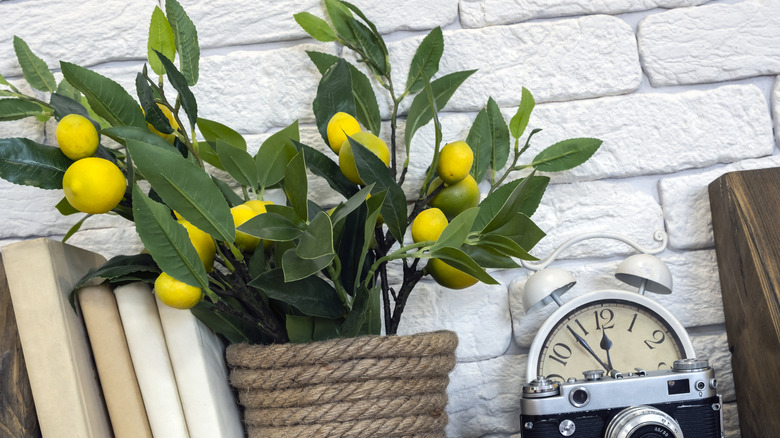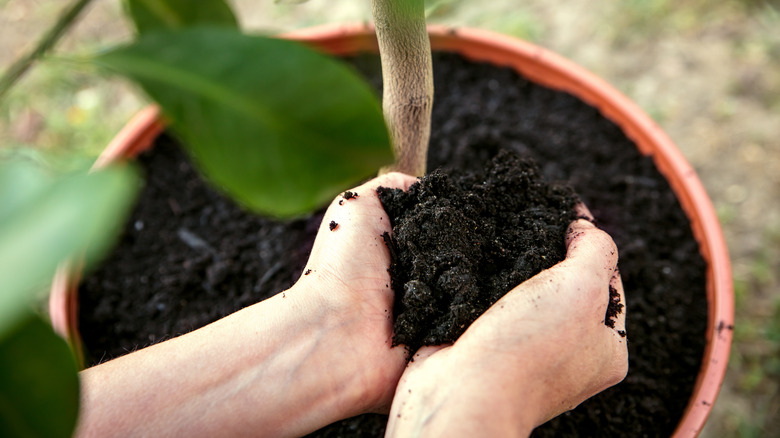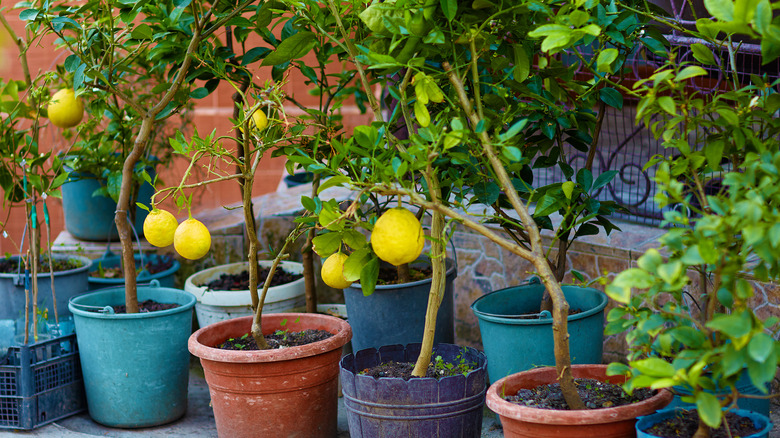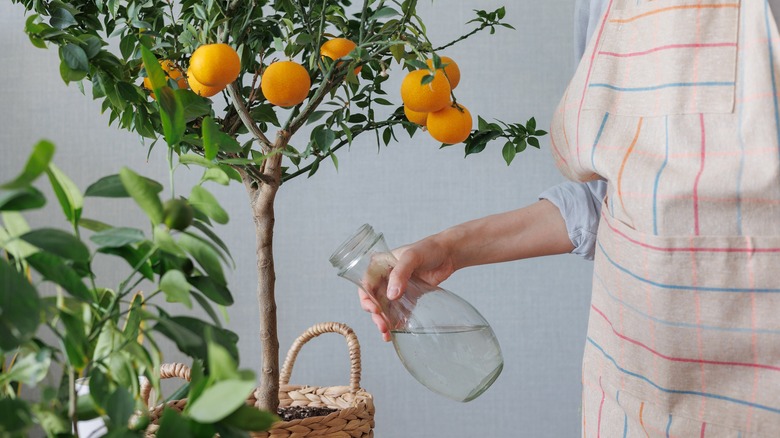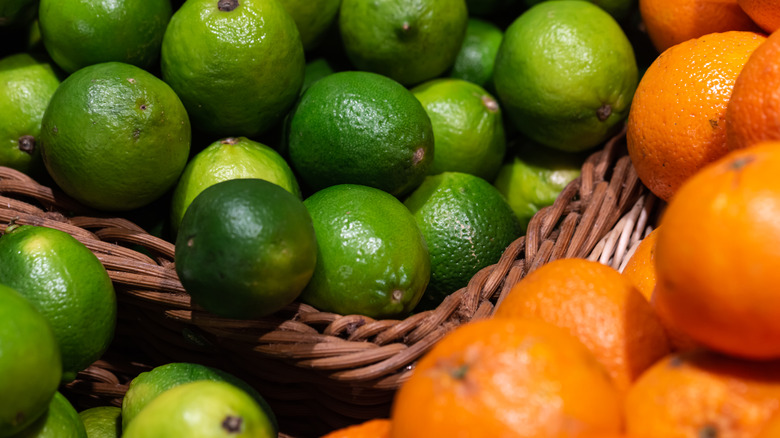Tips And Tricks To Keep Your Potted Citrus Trees Thriving Over The Years
If you're a fan of the tart, acidic flavor that fresh citrus fruits bring to meals and drinks, you can put them on your shopping list every week. Or, you can grow your own potted citrus tree inside and, in some climates, outside as well. From lemons to limes and oranges to tangerines, it's possible to keep a citrus tree thriving and producing fruit for many years, even if you live in a cold climate.
The most important thing to know before growing a citrus tree indoors is that you will be entirely in charge of the tree's four factors of health: water, soil, sunlight, and temperature. Consider which fruit you'd like to cultivate, and then be sure to obtain a dwarf variety to keep the tree a manageable size. Since most climates in the U.S. deal with frost or the threat of frost, make plans to get your container on wheels so you can move your tree outside for direct sunlight in warmer months, but inside to protect the plant in colder environments and during winter.
Get the right-sized pot and the right kind of soil
Pot size is important, especially at first. Use a 10- to 14-inch pot to start. A too-small pot won't allow the roots to grow properly, but one that's too large will make controlling the moisture level difficult. Your plant's health depends on sufficient drainage. Drill more holes in the bottom of the pot if it's too slow to empty after watering. Wet roots will lead to rot and mold, and it's tough for any plant to recover from root rot. When the roots start growing out of the pot's bottom, it's time for something bigger. Move the tree to a pot one size up, 16- to 20-inch diameter.
A citrus tree bears fruit when it's three to six years old. If you start with a tree, you'll be slightly ahead than if you started from seed. Most citrus trees are self-fertile. Flowering isn't seasonal but occurs in warmer weather and regular watering. You can also turn to hand pollination (you should try it) to help the plant bear fruit. Place your tree in standard potting soil available at garden centers. Don't use soil from your yard — it's too heavy and will retain too much moisture. There are also specialty garden centers and growers who create potting soil specifically for citrus trees. Just be aware that, in general, the soil should be light and loamy and have an even, sandy feel to it without large, moist clumps or balled-up chunks.
Keep lighting conditions and temperature consistent
Citrus trees are sun-seekers. They thrive on at least eight hours of sunlight each day. Place your citrus by a window where it will get natural light all day. If you're located further north with less than eight hours of sunlight in winter, consider using a grow light to keep your citrus tree happy. In summer, you can bring your indoor tree outside. But do this carefully since even a light-loving tree can get a sunburn if placed directly in the sun after weeks of being indoors. Keep your citrus tree in bright but indirect sunlight on your porch or patio, so it gains the benefit of sunlight and warm temperatures.
As a rule of thumb, consider that citrus trees are very like us. They withstand colder temperatures if needed but prefer a warmer environment. Outdoors, an established tree can withstand colder temps, but not freezing ones. If there's a possibility of frost, protect your tree by moving it inside. If frost or colder temperatures are a one-night thing in your area, it's still best to protect the tree by covering it with frost cloth or using incandescent lights to warm the air around the tree.
Water and nutrients
Citrus trees can live and bear fruit for decades with proper care. Part of the tree's general health depends on how much water it receives from your tap or rainfall. Humidity plays a factor here as well. In general, your potted citrus tree should be watered twice a week. These trees love the sun, but they love water as well. Water the tree thoroughly until it's running out of the drainage holes. Before the next watering, check the top 2 inches of the soil with your finger. If it's still damp, hold off soaking the plant until the top layer feels dry. Don't let the plant's soil dry out completely, but don't overwater. If the leaves are turning yellow and curling, you're overwatering.
Citrus trees use a lot of energy to produce fruit. To ensure you get high-quality lemons or limes, fertilize your tree every four to six weeks during spring and summer but not during winter months. Apply a fertilizer high in nitrogen in a ring around the base of the tree. Fertilization is more important for a young tree than for a mature one, but giving a fully grown tree nutrients once a year will help its general health.
What to grow?
Good starter citrus trees are Meyer lemons, makrut limes, Key limes, and Calamondin oranges; this keeps your tree scalable and could make your first attempt more successful. Grow what you want, of course! If you're looking to replicate grocery store citrus, consider the most common varieties. Most grocery store lemons are Lisbon or Eureka lemons. Meyer lemons are also popular, although this sweeter fruit is actually a cross between a citron and a mandarin. The most common lime in stores is the Persian (or Tahitian) lime, although Key limes, smaller with more intense flavor, are also prevalent in the market. A third lime, the makrut lime, has small, bitter fruit but highly aromatic leaves used in Southeast Asian cuisines, from Thai to Vietnamese dishes.
There are hundreds of varieties of oranges grown worldwide with different characteristics. The most popular in the U.S. include navel, Cara cara, and blood oranges and their smaller cousins, mandarins or tangerines. There are also citrus varieties that might be considered a bit more exotic yet still delicious, such as pomelos, grapefruit, kumquats, and yuzu. All are loaded with vitamin C and antioxidants, taste great, and are great for your health. Additionally, there are many uses for citrus around the house.
